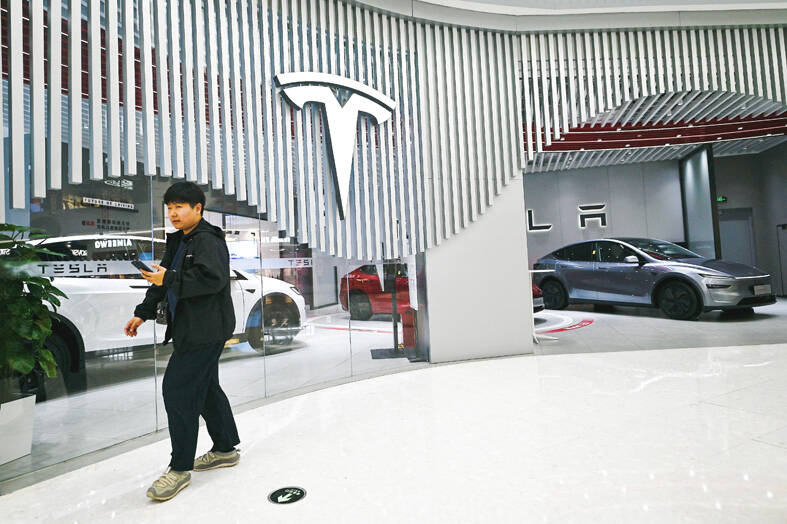Tesla Inc’s Web site in China has removed the ‘order now’ option for Model S and Model X electric vehicles (EV), which are both imported, just days after China retaliated against US President Donald Trump’s tariffs by raising levies of its own.
Tesla’s China Web site was offering an “order now” option for the two models as of the end of last month, an archived screen shot by Wayback Machine showed, but that had been removed as of yesterday. Existing inventory, such as a white Model S for 759,900 yuan (US$103,890), is still available.
Representatives for Tesla in China did not immediately respond to a request for comment.

Photo: AFP
Trump is imposing a 125 percent charge designed to counter the US’ trade deficit with China and punish Beijing for retaliating against US import taxes.
The number, published in a White House memo on Thursday, comes in addition to a 20 percent levy put in place earlier this year over China’s role in fentanyl trafficking, taking total tariffs on China to 145 percent.
China has hit back at the US, raising levies on all US goods to 84 percent.
Beijing has also said it would reduce the number of US films allowed to enter the country.
Tesla’s Shanghai factory only makes Model 3 and Model Y cars and most of them are either sold in China or exported to other parts of Asia. Anyone wanting to buy a Model S or Model X in China needs to get them imported.
However, the Model S and Model X only make a fraction of Tesla’s sales in China, at just less than 2,000 vehicles last year compared to about 661,820 for both the Model 3 and Model Y, data from the China Automotive Technology and Research Center showed.
Even though that would mean a huge hit to Tesla’s sales in the world’s biggest automobile market, Elon Musk’s EV maker has not been going well in China regardless.
Volumes from Tesla’s plant on the outskirts of Shanghai have been falling for six straight months, with first-quarter deliveries seeing a 22 percent decline. One of the largest threats to Tesla in China comes from BYD Co (比亞迪), which is now by far and away China’s No. 1 selling car brand.
Meanwhile, global deliveries for Tesla have slumped to the lowest level in three years, as Musk faces an international backlash over his involvement in politics.

SELL-OFF: Investors expect tariff-driven volatility as the local boarse reopens today, while analysts say government support and solid fundamentals would steady sentiment Local investors are bracing for a sharp market downturn today as the nation’s financial markets resume trading following a two-day closure for national holidays before the weekend, with sentiment rattled by US President Donald Trump’s sweeping tariff announcement. Trump’s unveiling of new “reciprocal tariffs” on Wednesday triggered a sell-off in global markets, with the FTSE Taiwan Index Futures — a benchmark for Taiwanese equities traded in Singapore — tumbling 9.2 percent over the past two sessions. Meanwhile, the American depositary receipts (ADRs) of Taiwan Semiconductor Manufacturing Co (TSMC, 台積電), the most heavily weighted stock on the TAIEX, plunged 13.8 percent in

A wave of stop-loss selling and panic selling hit Taiwan's stock market at its opening today, with the weighted index plunging 2,086 points — a drop of more than 9.7 percent — marking the largest intraday point and percentage loss on record. The index bottomed out at 19,212.02, while futures were locked limit-down, with more than 1,000 stocks hitting their daily drop limit. Three heavyweight stocks — Taiwan Semiconductor Manufacturing Co (TSMC, 台積電), Hon Hai Precision Industry Co (Foxconn, 鴻海精密) and MediaTek (聯發科) — hit their limit-down prices as soon as the market opened, falling to NT$848 (US$25.54), NT$138.5 and NT$1,295 respectively. TSMC's

TARIFFS: The global ‘panic atmosphere remains strong,’ and foreign investors have continued to sell their holdings since the start of the year, the Ministry of Finance said The government yesterday authorized the activation of its NT$500 billion (US$15.15 billion) National Stabilization Fund (NSF) to prop up the local stock market after two days of sharp falls in reaction to US President Donald Trump’s new import tariffs. The Ministry of Finance said in a statement after the market close that the steering committee of the fund had been given the go-ahead to intervene in the market to bolster Taiwanese shares in a time of crisis. The fund has been authorized to use its assets “to carry out market stabilization tasks as appropriate to maintain the stability of Taiwan’s

STEEP DECLINE: Yesterday’s drop was the third-steepest in its history, the steepest being Monday’s drop in the wake of the tariff announcement on Wednesday last week Taiwanese stocks continued their heavy sell-off yesterday, as concerns over US tariffs and unwinding of leveraged bets weighed on the market. The benchmark TAIEX plunged 1,068.19 points, or 5.79 percent, to 17,391.76, notching the biggest drop among Asian peers as it hit a 15-month low. The decline came even after the government on late Tuesday authorized the NT$500 billion (US$15.2 billion) National Stabilization Fund (國安基金) to step in to buoy the market amid investors’ worries over tariffs imposed by US President Donald Trump. Yesterday’s decline was the third-steepest in its history, trailing only the declines of 2,065.87 points on Monday and